No washing the dishes
I do not wash the dishes. Dish washing is stressful for my neck.
It turned out to be possible to cook and bake without having to wash the dishes.
Drinking cups
As drinking cups I use cardboard disposable cups.
In 2015 I bought a thousand of them for 63 Euros.
They are large cups of 480 ml.
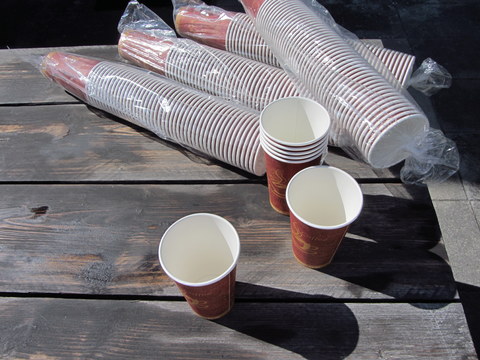
When I have leftovers that I want to keep in the fridge, then I use these cups as well.
I cover them with cling film. This way I don't have to wash any containers.
I bought a few double-sided stainless steel beakers in 2025.
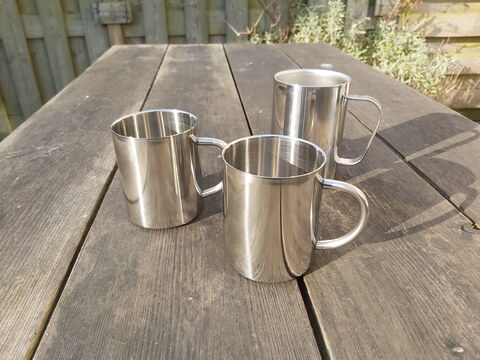
They are 400 ml (10 euros each) and 500 ml (12 euro each).
I have to wash these beakers now and then.
Cutlery and plates
My cutlery, my plate and my pan are entirely made of stainless steel.
After using my cutlery or my pan, I rinse it with water and a brush.
That is mostly just cold water from the tap.
Then I let it dry. When I need it the next time, then I just use it.
I use an induction cooker. That is much more convenient for me than a gas cooker.
Stainless steel plates are a lot easier to use than normal plates for me.
They are very light in weight and easier to rinse off.
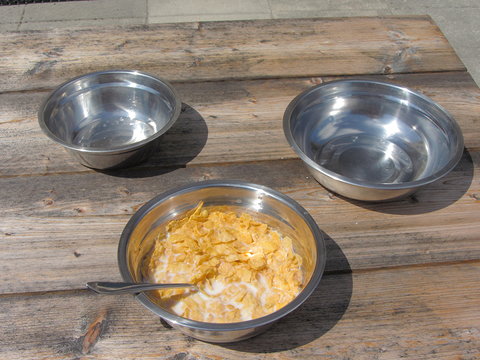
Below is a photo of my cutlery. This is almost the only cutlery
that I use for everything.
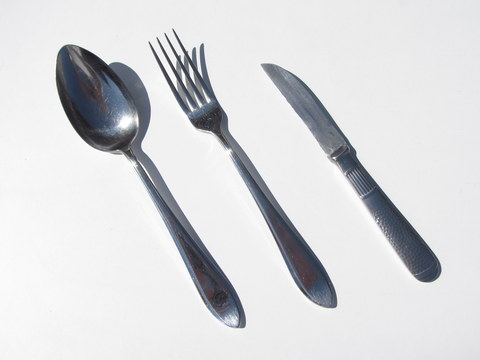
A peeler knife that is completely stainless steel and is not too small, was hard to find.
So I made that myself from a normal knife.
Below is a photo of the knife, and the peeler knife that I made from such a knife
by grinding away a part.
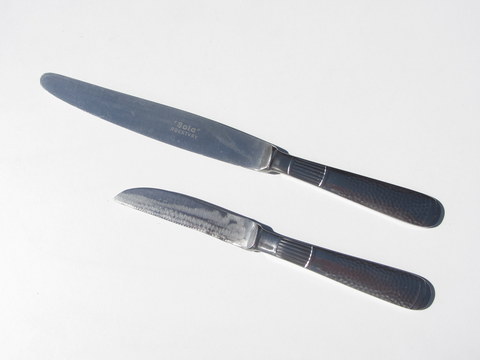
Pans
My pan is completely made of stainless steel:
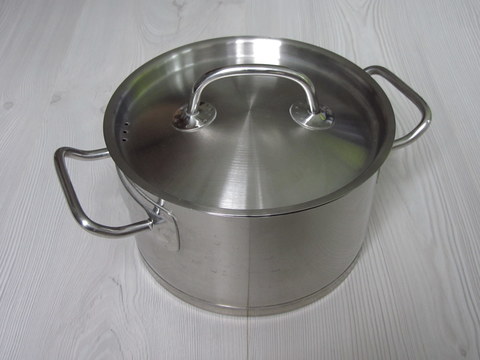
Pan: Sola Profiline deluxe 18 cm.
I had a non-stick skillet:
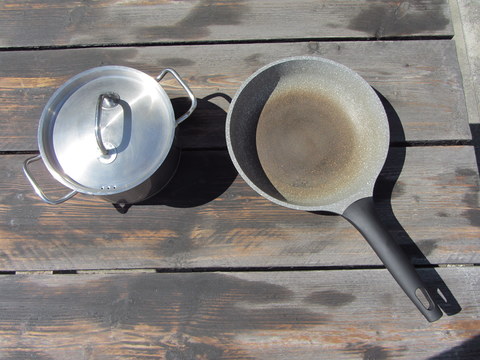
After three years of usage (and being careful), the non-stick layer was not good anymore.
After that I tried a skillet without a non-stick layer. They are often heavy.
A skillet of stainless steel is not the most ideal material,
but it was the only option for a skillet without non-stick layer that is
suited for an induction hob and which is not heavy.
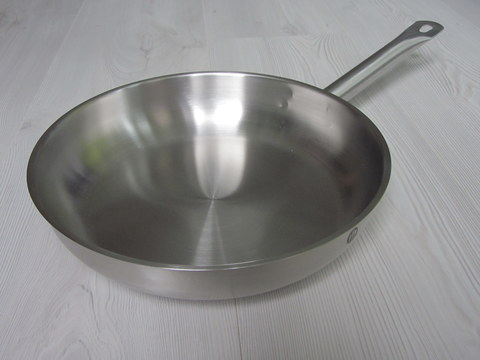
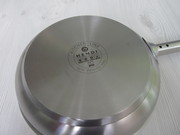
Merk: Hendi
Type: Kitchen Line 24cm
Prijs: 25 euros in 2018
Weight: 830 grams
This skillet works well with my induction cooker.
It works almost too well, even in the lowest setting the
skillet keeps getting warmer.
Below is the skillet after seasoning multiple times:
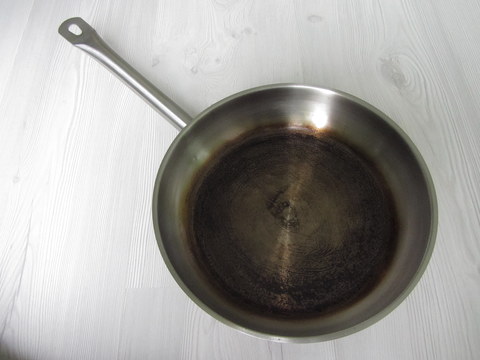
I don't use water, I clean the skillet with kitchen paper.
When something does stick to the skillet, then I heat up the
skillet and use kitchen salt and kitchen paper to rub it clean.
I use this frying pan only to make pancakes, because other things
stick easily to the frying pan.
Unfortunately, it happens now and then that something sticks to the pan in such a way, that I
have to completely clean the frying pan.
Then it is necessary to seasoning it again.
That takes a lot of effort, so in the end this stainless steel frying pan is not handy to use.
In 2025, I no longer use this frying pan.
The thermal conductivity of stainless steel is unfortunately bad.
The thermal conductivity of steel is better and even more for normal iron.
A frying pan or skillet made of carbon steel or forged iron should therefor be better.
That's why I tried a skillet made of sheet steel.
Below is a photo of the skillet after seasoning:
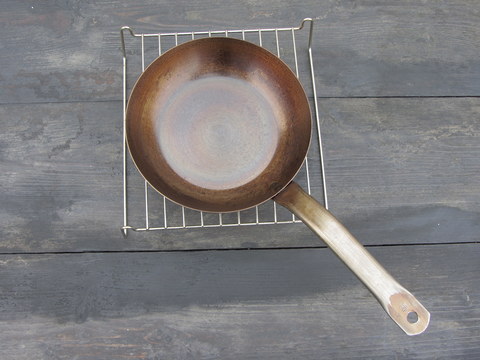
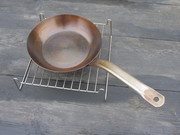
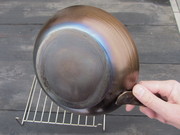
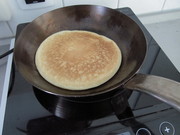
Brand: Helmensdorfer
Type: Lyonaiser 20 cm
Price: 22 euros in 2019
Weight: 860 grams
This skillet is unfortunately quite heavy.
For cooking and frying it is better than the stainless steel skillet.
When something sticks to it, is fairly easy to clean.
It can be used for baking, for stir-frying and for warming food.
I do not have to be careful with wooden or plastic spatulas.
I can use my stainless steel fork and knife.
If I would use a wooden or plastic spatula, then I would have to wash them off.
When using my fork and knife, I only rinse it with cold water.
When roasting meat, sometimes it sticks to the skillet.
To clean it, I use hot water (no soap). For the next use I add some
extra oil in the skillet.
I like this skillet a lot. It is not expensive and can last a lifetime.
It fits very well with my way of cooking without doing the dishes.
It is a relief to be able to just use it without having to be careful all the time.
Even the food tastes better.
To bake pancakes I put a tiny amount of oil in the frying pan and a
little oil in the batter. I pour the batter into the frying pan
and wait for two minutes, after that the pancake is loose in the pan.
Before I make the first pancake, I let the skillet heap up well
so the first pancake is just as good as the rest.
I do not need pans with a non-stick coating anymore,
but it would be nice if someone invented a way to make iron pans
lighter in weight and still be suitable for an induction cooker.
pancakes
When I bake pancakes, then I need something to make the batter in.
I managed to do that without having to wash the dishes as well.
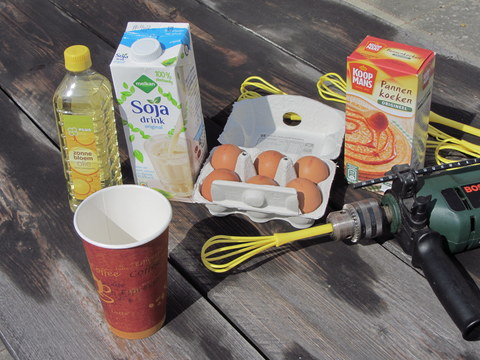
I bought small plastic mixers of 39 eurocents each.
They fit in an electric drill, because mixing the batter manually causes too much stress for my neck.
I could wash the mixers afterwards but I also can use them just once.
By making the batter in a disposable cup, no dishwashing is needed.
The cup is enough for a few pancakes.
Raw meat
When dealing with raw meat, fish or chicken, I make sure that almost
nothing comes in contact with the raw product. I use disposable gloves to handle the raw meat.
Some supermarkets sell vacuum-packed meat and salmon which can be placed in a
sous-vide without having to open the packaging.
Hygiene
Of course, I pay close attention to hygiene.
I rinse my cutlery and my plate and pan well, so nothing sticks to it.
There may of course be some oil (for example olive oil) left,
but that is not a problem in terms of hygiene.
My pan itself is heated during the next cooking session,
so my pan can not pose a problem.
The brush that I use to clean my cutlery and my pan must be clean,
so I put the brush sometimes in a cup with hot soapy water or washing soda or ten minutes in boiling water.
I regularly replace the kitchen towel. If I use a small cloth for
the countertop, it is no longer than one day on my countertop.
I think that I'm more hygienic than most others this way,
even though I do not wash the dishes.
When I put the dish brush in boiling water regularly, then it turns brown:
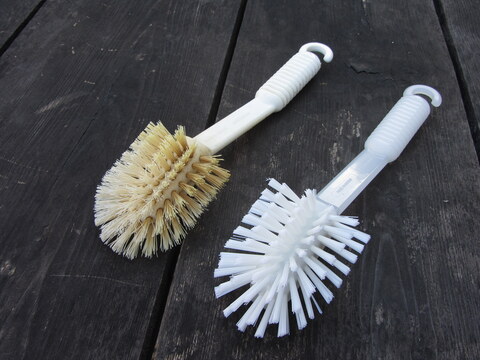
It seems that the brush does not turn brown when I add a little washing soda.
Dishwasher?
A dishwasher probably requires more actions and causes more troubles
for my neck and back then what I have now.
With a dishwasher I also have to bend a lot.
Since I don't have dishes anymore, a dishwasher is not needed.
Disadvantages: Plastic
From 2015 on, more and more experts say it is better to store food
in glass or in stainless steel. Even plastic that is suitable for food
may contain additives that are harmful and might leak into food.
Micro particles of plastic can get in the food, especially when heating
food in the microwave and with hot beverages.
Because of the way I deal with food, my food comes into contact with plastic a lot.
The disposable cardboard cups have a plastic layer inside.
When meat is in a sous-vide, then it is in a plastic bag for hours at a higher
temperature.
To relieve my neck, I hardly ever clean or cut vegetables.
Most of the time I use cut and washed frozen vegetables. They are in plastic
bags or in cardboard boxes which are coated with plastic.
Last change to this page: March 2025















